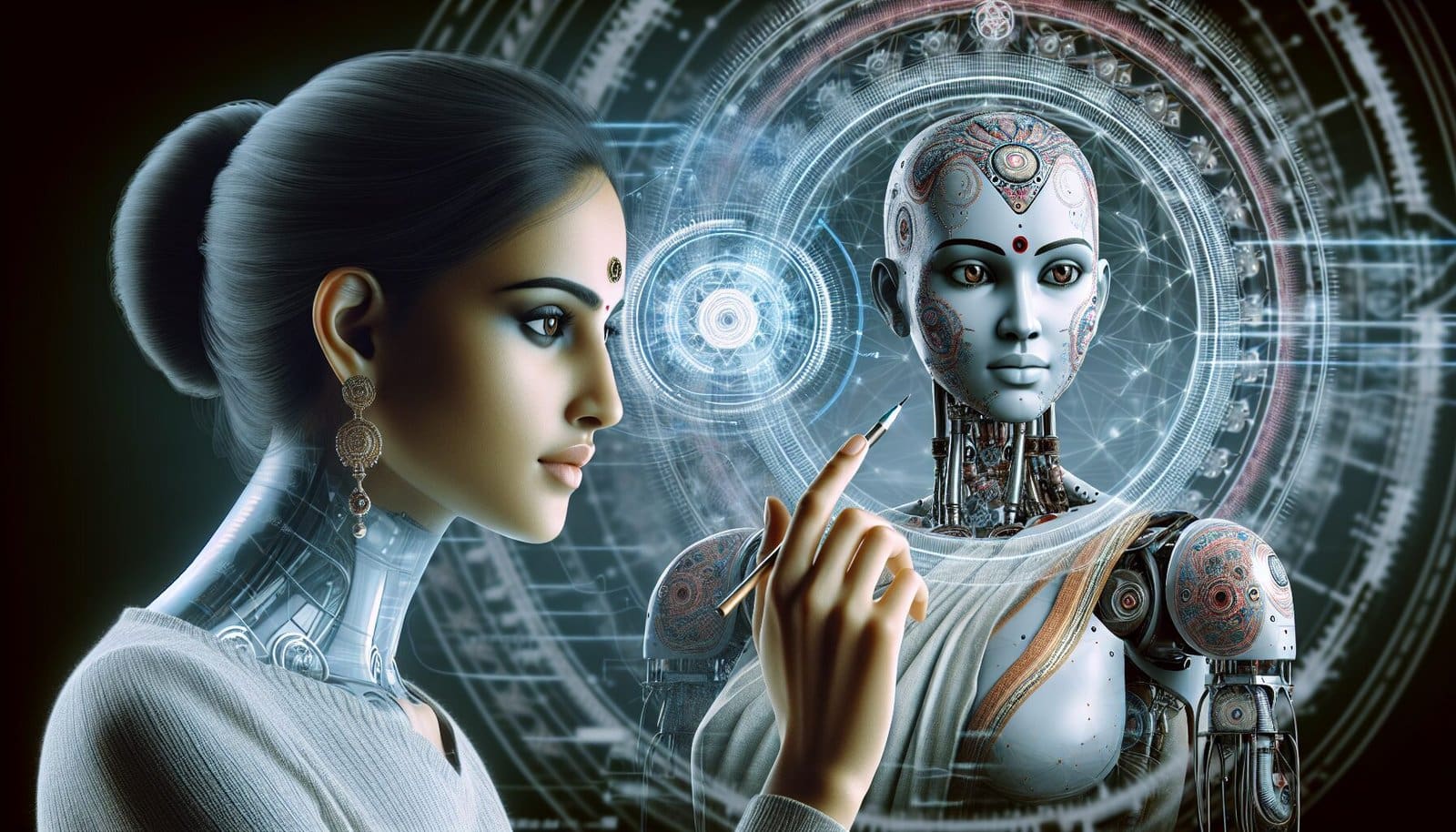Imagine a world where machines possess the power to see and understand the world around us, just like humans do. This is the incredible promise of the rise of Artificial Intelligence (AI) in computer vision. With AI algorithms rapidly advancing, computers are now able to analyze, interpret, and even make sense of visual data to an extent never thought possible. From autonomous vehicles to medical diagnostics, the potential applications of this game-changing technology are limitless. In this article, we will explore the profound impact and exciting possibilities that the intersection of artificial intelligence and computer vision presents to our society.
Artificial Intelligence and Computer Vision
Artificial intelligence (AI) and computer vision are two highly interconnected fields that have made significant advancements in recent years. While computer vision focuses on teaching computers to understand and interpret visual information, AI aims to develop machines that can simulate human intelligence and perform tasks that typically require human intelligence. The interplay between artificial intelligence and computer vision has resulted in groundbreaking applications and technological advancements across various industries.
Definition of computer vision
Computer vision, in simple terms, refers to the ability of a computer or machine to understand and interpret visual information from images or videos. It involves teaching machines to perceive and analyze visual data, enabling them to recognize objects, understand scenes, and extract meaningful information from visual inputs. Computer vision involves a combination of techniques from image processing, pattern recognition, and machine learning to enable machines to see and understand the world around them.
Definition of artificial intelligence
Artificial intelligence, often referred to as AI, is an area of computer science focused on the development of intelligent machines that can perform tasks that typically require human intelligence. AI encompasses various techniques and algorithms to enable machines to reason, learn, perceive, and understand natural language. It aims to create systems that can simulate human intelligence, exhibit traits like problem-solving, learning, and adaptability, and perform complex tasks with a high level of accuracy.
Interplay between artificial intelligence and computer vision
The fields of artificial intelligence and computer vision are highly interrelated and heavily depend on each other. While computer vision utilizes AI techniques to analyze visual data and extract meaningful information, AI leverages computer vision to perceive and understand the world. The integration of AI and computer vision has significantly expanded the capabilities of both fields and has led to the development of intelligent systems with advanced vision capabilities.
History of Computer Vision
Early developments in computer vision
The history of computer vision dates back to the 1960s when researchers began working on developing systems capable of interpreting visual information. Early efforts in computer vision focused on simple tasks like edge detection and image segmentation. These early developments laid the foundation for the field of computer vision and set the stage for future advancements in image understanding and interpretation.
Emergence of machine learning in computer vision
In the 1990s, machine learning techniques began to gain popularity in the field of computer vision. Researchers started exploring algorithms that could automatically learn patterns and features from visual data, enabling machines to recognize objects and understand scenes. The introduction of machine learning techniques significantly improved the accuracy and performance of computer vision systems and opened up new avenues for research and development.
Introduction of deep learning in computer vision
In recent years, deep learning has revolutionized the field of computer vision. Deep learning algorithms, specifically convolutional neural networks (CNNs), have proven to be highly effective in tasks such as image classification, object detection, and image segmentation. Deep learning models have the ability to learn complex features and hierarchies from vast amounts of labeled data, enabling them to achieve unprecedented levels of accuracy and performance in computer vision tasks.

Evolution of Artificial Intelligence in Computer Vision
Traditional approaches in computer vision
Before the emergence of deep learning, computer vision relied on traditional approaches such as handcrafted feature extraction and rule-based algorithms. These approaches involved manually designing features and using predefined rules to interpret visual data. While effective to some extent, these traditional methods often struggled with complex visual tasks and required extensive manual intervention.
Introduction of artificial neural networks
The introduction of artificial neural networks, particularly deep neural networks, marked a turning point in the evolution of artificial intelligence in computer vision. Neural networks, inspired by the structure and functionality of the human brain, can automatically learn hierarchical representations of visual information. This ability to learn directly from data and extract meaningful features has revolutionized computer vision and paved the way for advancements in areas such as object recognition, image classification, and scene understanding.
Integration of deep learning in computer vision
The integration of deep learning techniques, particularly deep convolutional neural networks, has brought about significant advancements in computer vision. Deep learning models have surpassed human-level performance in several computer vision tasks, such as object detection and image classification. The ability to learn complex features from vast amounts of data has led to breakthroughs in areas like autonomous vehicles, medical imaging, and facial recognition. Deep learning has enabled computers to understand and interpret visual information with impressive accuracy and reliability.
Applications of Artificial Intelligence in Computer Vision
The integration of artificial intelligence and computer vision has resulted in a wide range of applications that are transforming various industries. These applications leverage the power of AI to enable machines to analyze and understand visual information, opening up new possibilities in fields such as healthcare, transportation, security, and entertainment.
Object recognition and detection
One of the key applications of AI in computer vision is object recognition and detection. AI algorithms can analyze images and videos to identify and locate specific objects, enabling tasks such as automated surveillance, inventory management, and autonomous navigation.
Image classification and segmentation
AI-powered computer vision systems can classify images into different categories and accurately segment objects within images. This capability is useful in various fields, including autonomous driving, content moderation, and medical imaging.
Pose estimation and tracking
Computer vision algorithms combined with AI techniques can estimate the pose and track the movements of objects or human bodies in images or videos. This application finds applications in fields like animation, sports analytics, and virtual reality.
Scene understanding and interpretation
AI enables computer vision systems to understand and interpret complex scenes. By analyzing visual data, these systems can extract information about the environment, objects present, and the relationships between them. This application has implications in areas such as augmented reality, visual search, and robotics.
Medical imaging and diagnostics
AI-powered computer vision is transforming the field of medical imaging. By analyzing medical images, AI algorithms can assist in disease diagnosis, tumor detection, and treatment planning, leading to improved healthcare outcomes.
Autonomous vehicles and robotics
AI and computer vision play a crucial role in the development of autonomous vehicles and robotics. Computer vision algorithms enable vehicles and robots to navigate and interact with their surroundings, making them capable of performing tasks autonomously.
Video surveillance and security
AI-powered computer vision systems enhance video surveillance and security by automatically analyzing video feeds and identifying potential threats or anomalies. This application improves public safety and enables efficient monitoring of large areas.
Augmented reality and virtual reality
AI and computer vision are essential components of augmented reality (AR) and virtual reality (VR) technologies. By overlaying digital information onto real-world scenes, AR enhances the user's perception and interaction with their environment. VR creates immersive experiences by simulating a virtual environment. Computer vision enables these technologies to track and understand the real world, providing realistic and interactive experiences.
Quality control and inspection
AI algorithms can be used to analyze visual data in manufacturing processes, enabling automated quality control and inspection. Computer vision systems can identify defects, monitor production lines, and ensure product quality, improving efficiency and reducing human error.
Facial recognition and biometrics
AI-powered computer vision systems can recognize and identify individuals based on facial features. Facial recognition and biometric systems find applications in various domains, including security, access control, and user authentication.
Challenges in Artificial Intelligence for Computer Vision
While artificial intelligence has made remarkable progress in computer vision, there are several challenges that researchers and developers continue to address.
Data quality and quantity
AI models heavily rely on large amounts of high-quality labeled data for training. Obtaining such data can be challenging, especially for specialized domains or tasks. Data quality, diversity, and biases can also impact the performance and generalizability of AI models.
Computational power and resource requirements
Training and deploying deep learning models, especially large-scale models, require significant computational resources. This poses challenges, particularly for resource-constrained environments or applications that require real-time processing.
Robustness to variations in lighting, pose, and scale
AI models in computer vision should be robust to variations in lighting conditions, object pose, and scale. Ensuring models generalize well across different scenarios and exhibit consistent performance is an ongoing challenge.
Interpretability and explainability
Deep learning models often function as black boxes, making it challenging to interpret their decision-making process. Ensuring transparency and interpretability of AI models is crucial, particularly in sensitive domains like healthcare and security.
Privacy and ethical concerns
AI-powered computer vision systems raise concerns regarding privacy and ethical considerations. Facial recognition and surveillance technologies, for instance, have sparked debates around individual privacy, surveillance ethics, and potential biases.
Deployment and integration into real-world applications
Successfully deploying AI-powered computer vision systems into real-world applications can be challenging. Integration with existing infrastructures, accounting for domain-specific requirements, and addressing potential limitations and risks are critical aspects to consider.
Advancements in Artificial Intelligence for Computer Vision
Despite the challenges, significant advancements continue to unfold in the field of artificial intelligence for computer vision. These advancements aim to address existing limitations, improve model performance, and enable novel applications.
Improvements in accuracy and performance
Ongoing research and development efforts are focused on improving the accuracy and performance of AI models in computer vision tasks. Techniques like network architecture design, model optimization, and ensemble learning help push the boundaries of performance and enable state-of-the-art results.
Development of efficient algorithms and architectures
Efficiency and computational scalability are crucial aspects in the evolution of AI for computer vision. Researchers are working on developing efficient algorithms and architectures that strike a balance between performance and resource requirements. Techniques like knowledge distillation, model compression, and lightweight network designs aim to make AI models more accessible and practical.
Transfer learning and domain adaptation
Transfer learning and domain adaptation have emerged as key approaches to address data scarcity and address domain-specific challenges. By leveraging knowledge learned from a source domain, AI models can generalize to new, unseen domains and tasks, reducing the need for large amounts of high-quality labeled data.
Generative models in computer vision
Generative models, such as generative adversarial networks (GANs), enable the synthesis of new and realistic visual data. These models find applications in tasks like data augmentation, image inpainting, and style transfer, expanding the possibilities of creative applications in computer vision.
Explainable AI in computer vision
Ensuring transparency and interpretability of AI models is an ongoing research area. Efforts are being made to develop explainable AI techniques that provide insights into decision-making processes, making AI models more trustworthy, and facilitating diagnostic capabilities.
Deep reinforcement learning in computer vision
Combining deep learning with reinforcement learning techniques is a growing area of research in computer vision. Deep reinforcement learning enables AI models to learn to perform actions based on visual inputs and facilitates interactive and adaptive behavior in computer vision tasks.
Hardware acceleration for computer vision tasks
Hardware advancements, such as specialized processing units (GPUs, TPUs) and neuromorphic chips, enhance the efficiency and speed of AI models for computer vision. These advancements enable real-time processing and enable the deployment of AI systems in resource-constrained environments.
Combination of AI and other emerging technologies
The combination of AI with other emerging technologies like blockchain, Internet of Things (IoT), and 5G networks opens up new possibilities for computer vision applications. These technologies enable decentralized data sharing, real-time connectivity, and collaborative intelligence, amplifying the impact of AI in computer vision.
Future Trends in Artificial Intelligence for Computer Vision
Looking ahead, several trends are expected to shape the future of artificial intelligence in computer vision.
Continued integration of AI and computer vision
The interplay between AI and computer vision will deepen, with advancements in AI techniques fueling further progress in computer vision tasks. The integration of AI and computer vision will result in more intelligent and capable systems with broader understanding and interpretation of visual information.
Advancements in deep learning architectures
Ongoing research in deep learning architectures will lead to the development of more sophisticated models that can handle complex and nuanced visual tasks. Attention mechanisms, transformer architectures, and graph neural networks are examples of areas where significant advancements are expected.
Exploration of neuromorphic computing
Neuromorphic computing, inspired by the human brain's structure and functionality, holds promise for addressing the limitations of traditional von Neumann architectures. By mimicking the brain's parallelism and energy efficiency, neuromorphic computing can enable faster and more efficient AI models for computer vision.
Multimodal learning and fusion
The integration of multiple modalities, such as visual, textual, and auditory information, will become increasingly important in computer vision. Multimodal learning and fusion enable systems to leverage complementary information sources, improving performance and enabling a deeper understanding of visual scenes.
Real-time and edge computing in computer vision
Real-time and edge computing, where AI tasks are performed directly on devices or at the edge of the network, will become more prevalent in computer vision applications. This approach reduces reliance on cloud computing, enables faster response times, and enhances privacy and security by keeping data on-device.
Privacy-preserving AI in computer vision
Addressing privacy concerns will continue to be a focus in the development of AI-powered computer vision systems. Techniques such as federated learning, secure computation, and differential privacy will play a key role in ensuring data privacy and minimizing risks associated with sensitive information.
Collaborative and federated learning in computer vision
Collaborative and federated learning approaches, where AI models are trained collectively on distributed data sources, will gain prominence. These approaches enable AI models to learn from a larger and more diverse set of data while preserving privacy and data ownership.
Ethical considerations and regulation
As AI in computer vision becomes more pervasive, the need for ethical considerations and regulations will grow. Ensuring fairness, transparency, and accountability in AI systems will be essential in addressing potential biases, protecting privacy, and mitigating social, ethical, and legal implications.
Conclusion
The integration of artificial intelligence and computer vision has revolutionized the way machines perceive and understand visual information. From object recognition and image classification to medical imaging and autonomous vehicles, AI-powered computer vision systems have found applications across various industries. While challenges such as data quality, computational requirements, and ethical concerns persist, advancements in deep learning, efficient algorithms, and hardware acceleration continue to drive progress in the field. Looking ahead, the continued integration of AI and computer vision, along with emerging trends in deep learning architectures, neuromorphic computing, and privacy-preserving techniques, promise a future where AI-powered computer vision systems can perceive, understand, and interpret visual information with unprecedented accuracy and reliability.










